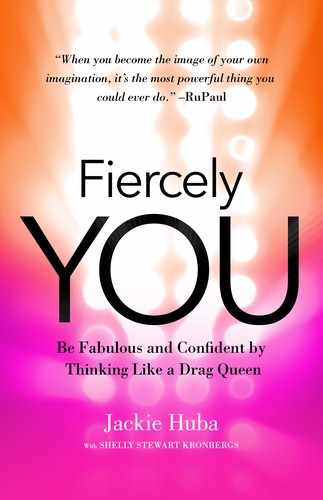A DRAG PRIMER
![]()
Know Your Herstory
Drag queens have a long and storied history, and it’s important for the context of this book that you not only know the background information but how important drag queens are to the entire LGBT community.
THE ORIGINS OF DRAG
History is a bit unclear on where the term “drag” came from, although many attribute it to Shakespearean theater where women were not permitted to act on stage, men played the female roles “DRessed As a Girl,” and “drag” is an acronym for this.
Perhaps the first well-known American drag performer was Julian Eltinge, who began performing in drag at age ten. In 1904, at age twenty-three, he was appearing on Broadway in drag. In 1910, at the height of his drag fame, he went on a national tour of America and produced his own magazines, one of which was aimed at his sizeable female audience and shared beauty hints and tips.
CATEGORIES OF DRAG
There are as many styles of drag as there are colors of nail polish. Some of the more prominent drag styles include:
• High drag, which is based on clownish devices such as exaggeration, satire, and ribaldry. Everything is over-the-top—big boobs, big hair, big hips, and so on.
• Fishy, in which queens attempt to look as much as possible like real women in their makeup and clothing.
• Pageant queens are queens who compete regularly in drag pageants. A drag pageant is very similar to a female beauty pageant, with judged categories that include gown, talent, and onstage questions.
• Celebrity impersonators are queens who perform in the style of a specific celebrity. Sometimes resorting to plastic surgery, they aim to act and look like the star they are portraying. Favorite personalities for celebrity impersonators include Cher, Madonna, Tina Turner, Liza Minnelli, Reba McIntyre, and Barbra Streisand.
• Skag drag is a style of drag where queens do not attempt to hide their male appearance. Although they use makeup and may wear a dress, they may also sport a full beard and expose their hairy beer belly.
• Postmodernist drag queens, “tranimal,” or “terrorist drag” mix performance art, punk rock, and racial and social issues into drag. Many of these types of queens often use unkempt wigs and clothing.
• Camp queens go for the comedy angle. This can be showcased in their makeup, costumes, performance, or any mix of these.
Drag has also long been part of pop culture in movies, television, music, and theater. Some of the more prominent recent examples of this include:
• Music, like Madonna’s 1990 number-one song “Vogue,” which showcased voguing, a style of dance popularized in the New York City drag ball scene, and of course, RuPaul’s 1992 dance hit “Supermodel.”
• Television, including the Tom Hanks’ vehicle Bosom Buddies and RuPaul’s Drag Race, now in its eighth season, the most popular show on MTV’s LOGO network.
• Movies: The Bird Cage, To Wong Foo Thanks for Everything, Julie Newmar, and Tyler Perry’s eight movies portraying his Madea character.
• Broadway: Tony award–winning shows such as Hedwig and the Angry Inch, and Kinky Boots.
DRAG QUEENS’ ROLE IN THE FIGHT FOR LGBT RIGHTS
After World War II, Wisconsin senator Joseph McCarthy stoked national paranoia in America. What does this have to do with drag? Well, anything that was deemed “subversive” (e.g., the Communist Party, homosexuals) was also thought of as a risk to the country. In the 1950s, the FBI began tracking “known homosexuals,” even posting their names in local newspapers. The wearing of opposite-gender clothes was banned, and gay men and women were often publicly humiliated, harassed, fired from jobs, jailed, or institutionalized. Police began raiding gay establishments in cities across the country, revoking liquor licenses and arresting patrons. Anyone with an ID was booked and released; anyone without an ID was arrested, as well as anyone who wasn’t wearing at least three pieces of clothing that matched their sex.
The Stonewall Inn was the only gay bar in New York City, and in 1969 it became the birthplace of the modern gay rights movement. Raids became increasingly frequent in the summer of 1969, and finally, on June 28th of that year, the patrons were pushed too far. At 1:20 a.m. on that fateful day, the police raid did not go as planned. For the first time, the patrons fought back. Many believe riots were instigated after drag queen Sylvia Rivera threw pennies and quarters at police. Three nights of riots ensued, which included another drag queen, Marsha P. Johnson, smashing a police car window with her purse.
This was the first time LGBT people had protested as a community. The events at Stonewall ignited widespread, worldwide protests. In 1970, to mark the first anniversary of the Stonewall uprisings, the very first Gay Pride marches took place in New York, Los Angeles, San Francisco, and Chicago. Drag queens were instrumental in the first fight to gain equality for the LGBT community and should be celebrated as such.
WANT TO LEARN EVEN MORE ABOUT DRAG HERSTORY?
Here’s a list of some important films and documentaries for you to peruse:
• Paris Is Burning: the seminal 1990 documentary film by Jennie Livingston on drag ball culture in New York City.
• Pay It No Mind: The Life and Times of Marsha P. Johnson: a documentary film about the legendary transgender drag queen activist. As of this writing, it is only available on YouTube.
• Pageant: a documentary film that showcases the world of drag pageants.
• I Am Divine: a documentary film about how Harris Glenn Milstead became John Waters’s cinematic muse and an international drag icon.
